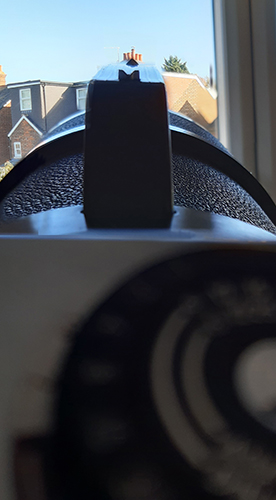by TRA
The Zoomar/Kilfitt
Sport-Reflectar 1000mm f/8
mirror lens for
the Pentacon Six
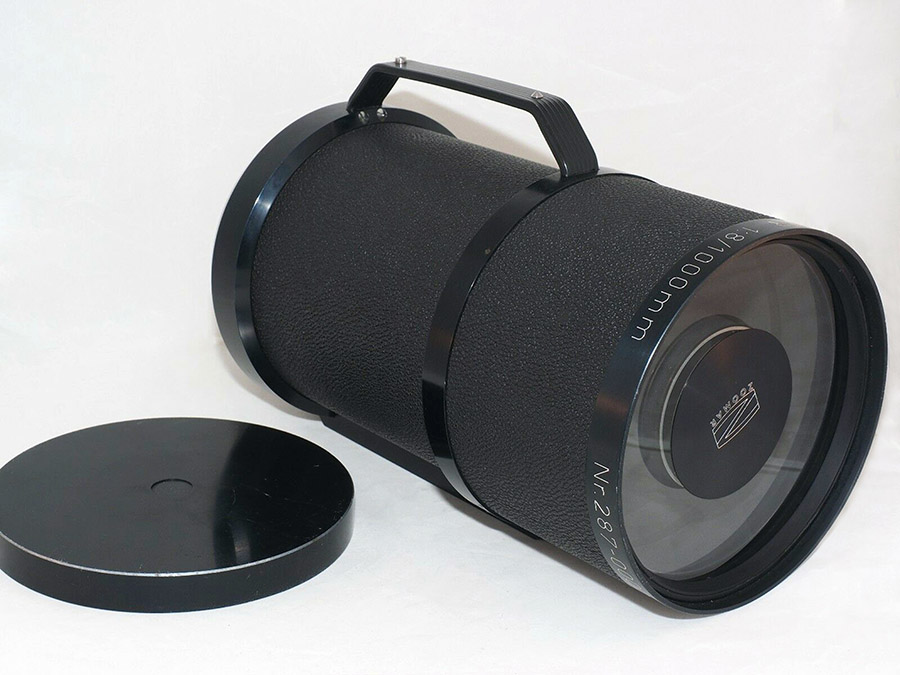
The 1000mm Sport Reflectar, We
note the strong, metal front lens cap!
[1000_Reflectar_01.jpg]
Pont states (p. 76) that there is only
one serial number known for this lens. Here is a
second one! It has a WE camera adapter mount,
which means that, amongst the vast number of cameras for
which Kilfitt produced mounts, there is one for the
Pentacon Six: the WESI mount. According to Pont
(p. 77), other mounts included:
WEHA – Hasselblad 2000
WERI –
Rittreck/Norita
FUEPE – Pentax 67
WEMA – Mamiya 645
There are of course also
numerous mounts for 35mm cameras, and if a lens has
the WESI mount for the Pentacon Six / Praktisix,
converters from this mount to numerous other cameras,
including the newest mirrorless digital cameras, are
readily available, both new and second-hand.
The 1000mm
Zoomar/Kilfitt Sport-Reflectar compared with the
1000mm Carl Zeiss Jena Spiegelobjektiv
Let us first compare tihs Kilfitt lens
with the Carl Zeiss Jena 1000mm mirror lens. The
following photograph and caption is from the article by
Carsten Bobsin in Photo Deal Nr. 76, I/2012 (Januar
Februar März) p. 25. Below the image we translate
the caption.
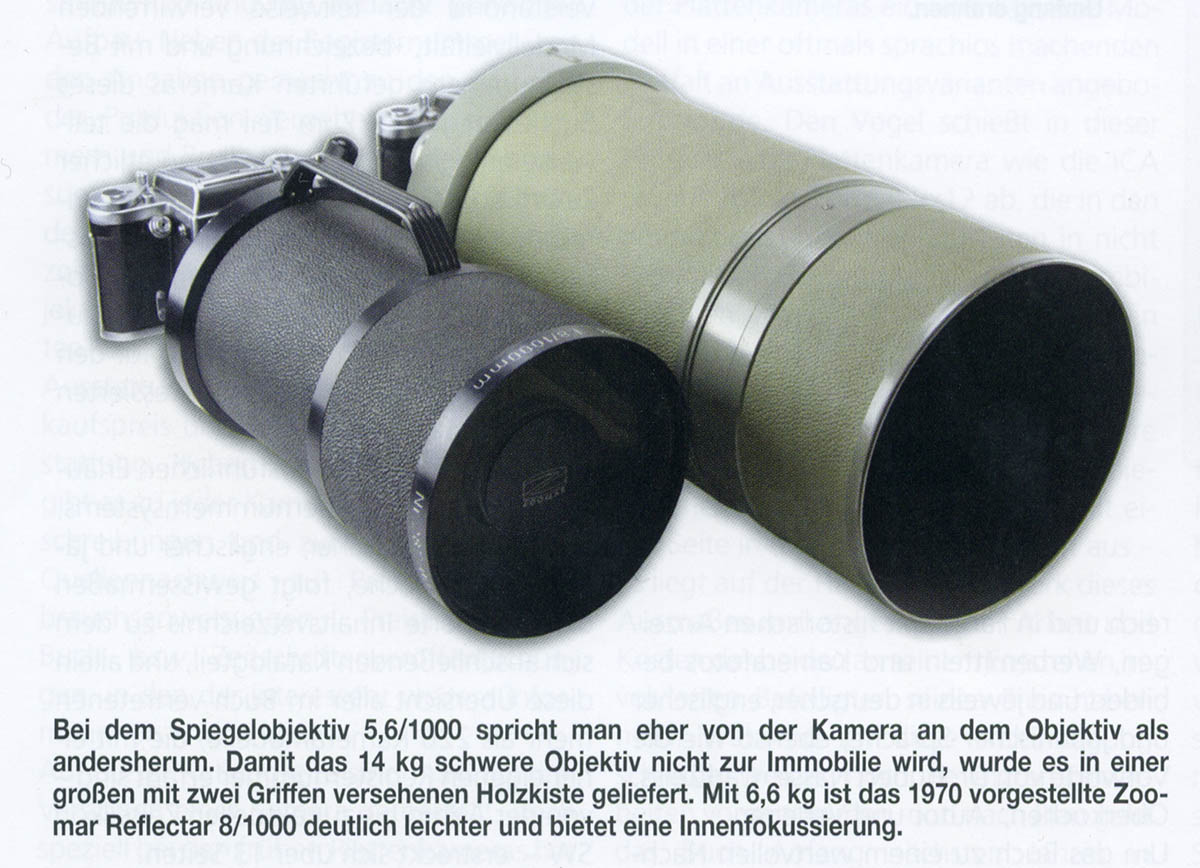 “With the
5.6/1000 Mirror lens one speaks more of
putting the camera onto the lens rather than
the other way round. So that the 14 kg
heavy lens does not become a piece of real
estate property that cannot be moved, it
is supplied in a large wooden case with two
handles.
At 6.6 kg, the Zoomar Reflectar 8/1000 that was presented to the public in 1970 is substantially lighter and provides internal focussing.” [1000mm_Reflektar_u_CZJ.jpg] |
As well as the very-visible difference in
size, we also note that the Kilfitt/Zoomar lens has a
carrying handle, which in practice is extremely
useful. At 14kg, getting the Carl Zeiss Jena lens
onto a tripod is not easy and requires a good
technique. At less than half the weight – and with
the carrying handle – the Kilfitt Sport Reflectar is
easy to handle. Of course, this 1000mm Zoomar has
a maximum aperture of f/8, one stop “slower” (smaller)
than the f/5.6 of the Carl Zeiss Jena 1000mm lens.
However, when shooting pictures of the moon (see here), we found that f/5.6
was almost larger than we needed!
We would also expect slightly more depth of field at f/8
than at f/5.6, not a negligible point with such a long
lens. After all, how often do we take pictures
with an aperture of f/5.6? It is not normally the
aperture that is required to get the best image from a
lens.
The 1000mm Zoomar Sport-Reflectar
compared with the 500mm Kilfitt/Zoomar
Sport-Reflectar
To give a further indication of the size
of this Kilfitt lens, let us compare it with the Kilfitt
500mm Sport Reflectar, which is reported on here on this website.
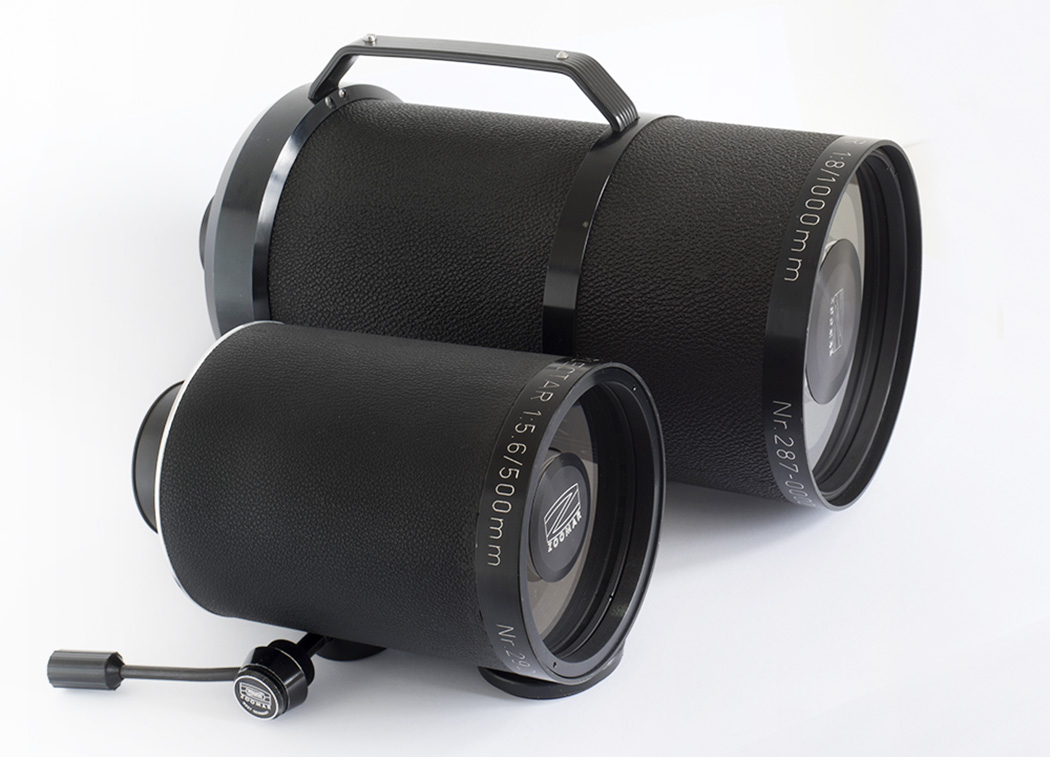 Here we can see the focussing lever of the 500mm mirror lens. [k1000mm_15.jpg] |
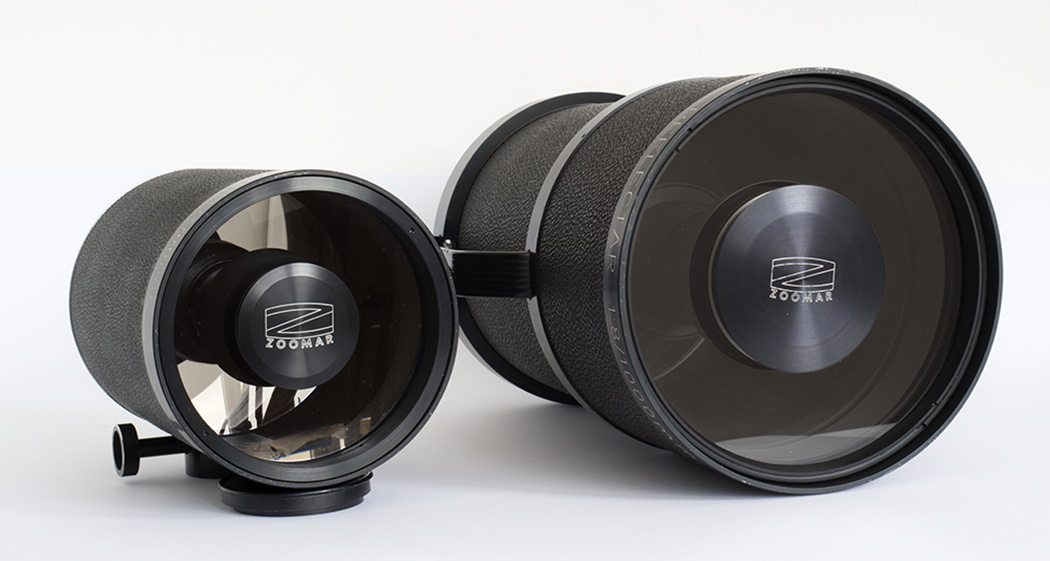 [k1000mm_10.jpg] Both of these
lenses have inner focussing, which means that
the length of the lens does not change as one
focusses, in contrast with the Carl Zeiss Jena
Spiegelobjektiv, which has bellows at the back
of the lens to provide focus. Both Zoomar
lenses also have a focussing lever, while the
Zeiss lens has a focussing wheel. See
details of the back of the Zeiss lens here.
|
Mounting the 1000mm Zoomar Sport-Reflectar on a tripod
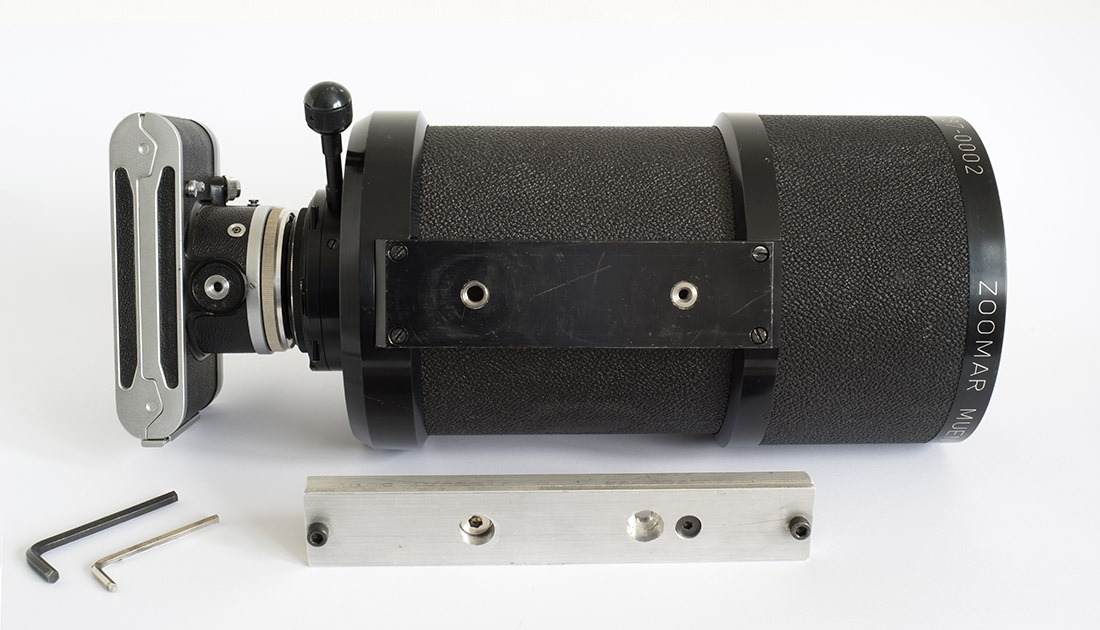 [k1000mm_06.jpg] The 1000mm Zoomar
has a base that is long, wide and strong and is
provided with two tripod sockets, one for ¼" and the
other for 3/8".
I am here using one of my Arca-Swiss-compatible tripod-mounting plates, on which more details can be seen here. I found that if I just used one of the sockets, the lens could swing on the mounting plate, so I had a second hole drilled in the plate at the right distance, so that both sockets on the lens could be used. As each mounting bolt has a different diameter, I have two Allen keys, one for each bolt, visible on the left in this photograph. We can here also see the focussing lever for the lens, which has here been mounted on a Praktisix camera. To the right, the lens is mounted on the Arca-Swiss B1-G ball head, which is on the Berlebach tripod. I think that in fact the Benro tripod described here would have no difficulty supporting this lens safely. |
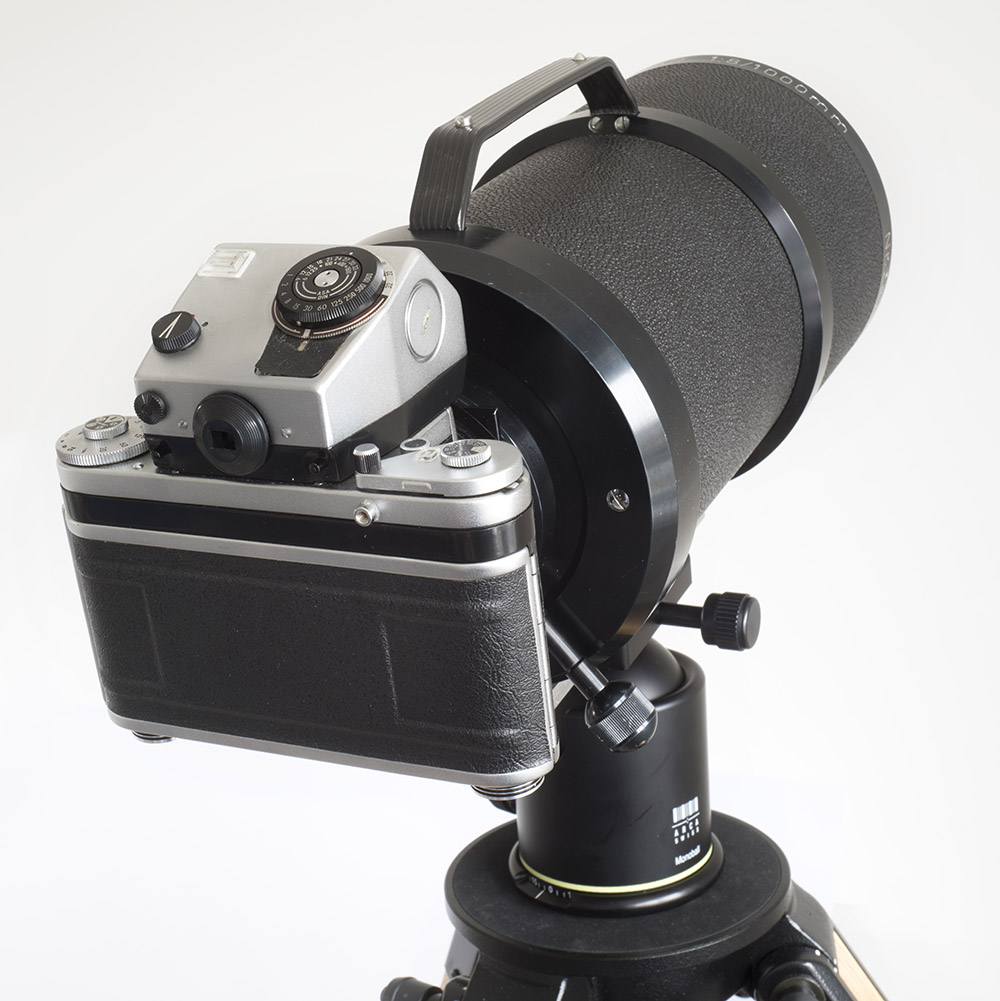 [k1000mm_18.jpg] Here one of the
latest Pentacon Sixes, with the added mirror
pre-release mechanism (see here),
has been mounted on the lens. The lens
focussing lever is pointing down at about
50º. The knob on the end of the lever
enables focus to be locked at any point.
(The horizontal knob that is further forward is
part of the locking mechanism on the tripod ball
head.)
|
Aids for the user
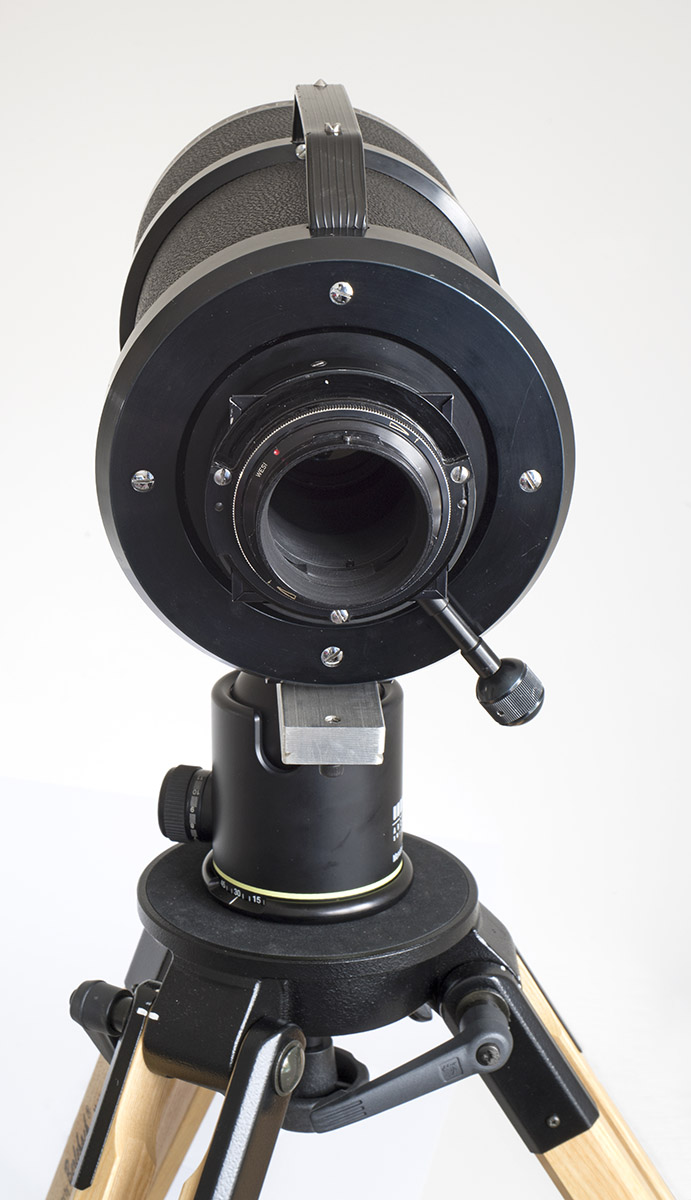 [k1000mm_22.jpg |
In this
photographer’s-eye-view of the lens (minus
camera), we can see further features. Here the lens has a WESI mount for the Pentacon Six. Between this mount and the back of the lens we can see the square corners of something. This is the filter holder, for – in true Kilfitt style! – this lens can take gelatine filters. This is potentially much more flexible than the filter system on the Carl Zeiss Jena 1000mm mirror lens, which admittedly had built-in filters, although these had been designed in the 1950s at a time when much photography was in black and white, so the filters available were UV, ND, Yellow, Orange, Light Red, Dark Red, the colour filters all having been chosen to darken the sky and enhance clouds to varying degrees with black-and-white photography.
|
||||
Because of the Covid pandemic
restrictions and the onset of winter in the northern
hemisphere, it is likely to be several months before we
are able to publish the results of tests with this
lens. As always, we will notify visitors via the upgrades page.
To go on to the next Kilfitt lens, click
below.
Kilfitt Multi-Kilar
lens converter
To see information on the 500mm Kilfitt/Zoomar Sport
Reflectar mirror lens, click here.
To go to the lens test section, click here.
To go to the introduction to Kilfitt data, click here.
To go back to the beginning of the Lens Data section,
click below and then choose the range of lenses that you
want to read about.
Back to beginning of the Lens Data
section
To choose other options, click below.
Home
© TRA First published: November 2020
